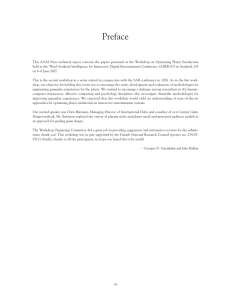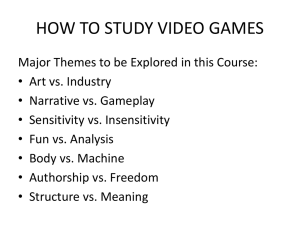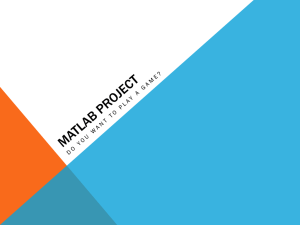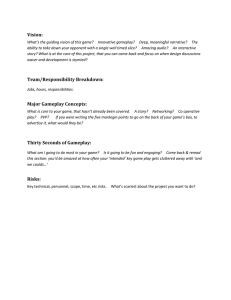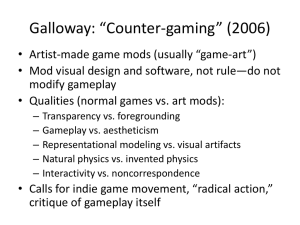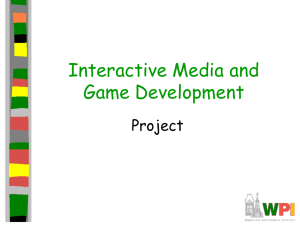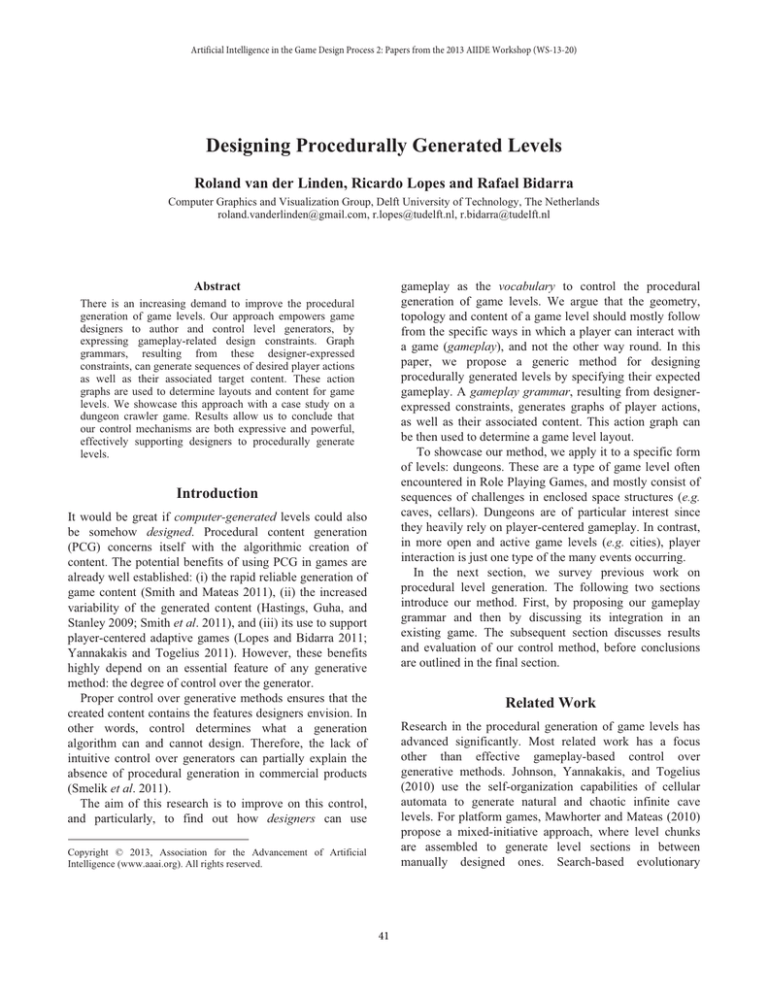
Artificial Intelligence in the Game Design Process 2: Papers from the 2013 AIIDE Workshop (WS-13-20)
Designing Procedurally Generated Levels
Roland van der Linden, Ricardo Lopes and Rafael Bidarra
Computer Graphics and Visualization Group, Delft University of Technology, The Netherlands
roland.vanderlinden@gmail.com, r.lopes@tudelft.nl, r.bidarra@tudelft.nl
gameplay as the vocabulary to control the procedural
generation of game levels. We argue that the geometry,
topology and content of a game level should mostly follow
from the specific ways in which a player can interact with
a game (gameplay), and not the other way round. In this
paper, we propose a generic method for designing
procedurally generated levels by specifying their expected
gameplay. A gameplay grammar, resulting from designerexpressed constraints, generates graphs of player actions,
as well as their associated content. This action graph can
be then used to determine a game level layout.
To showcase our method, we apply it to a specific form
of levels: dungeons. These are a type of game level often
encountered in Role Playing Games, and mostly consist of
sequences of challenges in enclosed space structures (e.g.
caves, cellars). Dungeons are of particular interest since
they heavily rely on player-centered gameplay. In contrast,
in more open and active game levels (e.g. cities), player
interaction is just one type of the many events occurring.
In the next section, we survey previous work on
procedural level generation. The following two sections
introduce our method. First, by proposing our gameplay
grammar and then by discussing its integration in an
existing game. The subsequent section discusses results
and evaluation of our control method, before conclusions
are outlined in the final section.
Abstract
There is an increasing demand to improve the procedural
generation of game levels. Our approach empowers game
designers to author and control level generators, by
expressing gameplay-related design constraints. Graph
grammars, resulting from these designer-expressed
constraints, can generate sequences of desired player actions
as well as their associated target content. These action
graphs are used to determine layouts and content for game
levels. We showcase this approach with a case study on a
dungeon crawler game. Results allow us to conclude that
our control mechanisms are both expressive and powerful,
effectively supporting designers to procedurally generate
levels.
Introduction
It would be great if computer-generated levels could also
be somehow designed. Procedural content generation
(PCG) concerns itself with the algorithmic creation of
content. The potential benefits of using PCG in games are
already well established: (i) the rapid reliable generation of
game content (Smith and Mateas 2011), (ii) the increased
variability of the generated content (Hastings, Guha, and
Stanley 2009; Smith et al. 2011), and (iii) its use to support
player-centered adaptive games (Lopes and Bidarra 2011;
Yannakakis and Togelius 2011). However, these benefits
highly depend on an essential feature of any generative
method: the degree of control over the generator.
Proper control over generative methods ensures that the
created content contains the features designers envision. In
other words, control determines what a generation
algorithm can and cannot design. Therefore, the lack of
intuitive control over generators can partially explain the
absence of procedural generation in commercial products
(Smelik et al. 2011).
The aim of this research is to improve on this control,
and particularly, to find out how designers can use
Related Work
Research in the procedural generation of game levels has
advanced significantly. Most related work has a focus
other than effective gameplay-based control over
generative methods. Johnson, Yannakakis, and Togelius
(2010) use the self-organization capabilities of cellular
automata to generate natural and chaotic infinite cave
levels. For platform games, Mawhorter and Mateas (2010)
propose a mixed-initiative approach, where level chunks
are assembled to generate level sections in between
manually designed ones. Search-based evolutionary
Copyright © 2013, Association for the Advancement of Artificial
Intelligence (www.aaai.org). All rights reserved.
41
algorithms were investigated for the generation of game
levels. In one example, Valtchanov and Brown (2012) use
their fitness function to optimize topology generation, by
specifying a strong preference for dungeons composed of
small, tightly packed clusters of rooms, inter-connected by
hallways. Roden and Parberry (2004) proposed a pipeline
for generating underground levels. The authors also use
constraints to control graph (level) generation. However,
their constraints directly relate to the topology and
geometry of a level, and not to gameplay.
For our purposes, gameplay-based control over
generative methods is more interesting and relevant, as it
has allowed player-based rhythm, game narratives and
game missions to steer level generation. Smith et al. (2009)
propose a two-layered grammar-based approach to
generate platform levels. Player actions (like jumping) are
also used, but only to define desired interaction rhythms,
which then constrain level generation. Hartsook et al.
(2011) use a genetic algorithm to create 2D role playing
game worlds. The initial genetic representation captures
linked narrative events and the fitness function optimizes
correct sequencing. This way, narratives that are
meaningful to the player steer the generation.
Dormans' (2010, 2011) work on grammars to generate
dungeons shares most similarities with our research.
Missions are generated through a graph grammar,
representing sequential player tasks. This mission graph is
then used by a shape grammar to create a corresponding
game space. Recipes are created by designers to instruct
the generator how to re-write grammar rules. Our generic
approach aims for a wider range of application, to both
games and genres, than done before. The main distinct and
novel contributions are: (i) tasks can be created from
scratch, with associated game content, (ii) parameters to
control the generative grammar can be freely specified and
manipulated, and (iii) additional spatial relationships,
beyond “key-lock” pairs, can be specified and controlled.
expressed as (design) constraints. These designer-authored
constraints directly result in a generative graph grammar,
i.e. a gameplay grammar, and multiple grammars can be
expressed through different sets of constraints. A grammar
is thus tailored by a designer to fit a specific game. It is
able to generate graphs of player actions which
subsequently determine layouts for game levels. For each
generated graph, specific content should be synthesized by
following the graph’s constraints, for example, by placing
in a game level the objects required by each action, in the
appropriate sequence.
Expressing Design Constraints
In our grammar-based method, designers author level
generators by expressing their design constraints, specified
as player actions, their relationships and related content. A
player action, also considered by Smith et al. and
Dormans, describes gameplay by inherently indicating
what a player can do in a level. There is no universal set of
actions, so for each game, designers have to specify their
own. Constraints were implemented into Entika (Kessing,
Tutenel and Bidarra 2012), a semantic library editor used
to express semantic attributes and relationships as
constraints to layout solving.
Individual player actions are specified as a verb and a
target, e.g. kill a dragon. Targets typically relate to game
content, e.g. the dragon in kill a dragon. Content refers to
the objects, non-playing characters (NPC) and their
relationships. Entika allows you to directly specify this
target as a semantic entity linked to content (e.g. a 3D
model, a procedure). This can even be expressed in more
abstract terms, like other constraints to be solved later (e.g.
“some animal with scales”).
Player actions are most interesting and useful if they are
considered in logical groups and not individually.
Sequences of actions, and even branching sequences
(representing player choices), can capture more complex
and intricate gameplay. As such, player actions can also be
grouped and specified as a compound, where the whole
composition of sub-actions is represented by a single
name. For example, as seen below, acquiring a key can be
fulfilled by killing an enemy and then looting the key from
its body. Furthermore, each sub-action can itself be a single
or compound action. Sequences of actions can also include
branching, to capture player choices or alternatives
(resembling the logical ‘or’ operator, ||). Below we see an
example, with two alternatives of action sequences to
fulfill entering a locked chamber.
Gameplay Grammars
Typically, the geometry and content of a designed game
level follow from gameplay requirements, not the other
way round. This happens because gameplay naturally
determines which unique content is required, whereas
content can be ambiguous as to which gameplay it sustains.
Optimizing content to match gameplay is more natural,
since it is more appropriate in the level design setting.
Our approach allows designers to author procedurally
generated levels, empowering them with intuitive control
over the generative methods. Control is realized a priori,
by specifying all the design constraints, expressed in a
gameplay design-oriented vocabulary. Player actions to
perform in game (e.g. fighting), their sequencing,
relationships and content (e.g. fighting a dragon) can be
Action 1: Acquire key
Sub-actions: Kill an enemy → Loot key from body
Action 2: Enter locked chamber
Sub-actions: (Acquire key → Unlock related door → Move
through doorway) || (Climb on roof → Enter chimney)
42
indicate their order. Eventually, this information in the
graph will determine a game level layout.
Different sets of designer-specified constraints result in
distinct gameplay grammars, which is a first way of
controlling generation. Additionally, generation can also be
controlled by setting the initial parameter values of a single
grammar which, as explained before, will steer the
selection of the corresponding re-writing options.
The initial graph is composed of a set of start action
node(s). The generative algorithm re-writes compound
actions into a sub-graph of linked actions. It takes the
following steps while a single compound action still exists:
1. Select the first compound action in the graph
2. Select an option based on parameter values
(randomly, if no conditions are set)
3. If needed, randomly select sub-options
4. Convert the selected rewriting option to a graph of
sub-action nodes (sub-graph).
5. Add the compound action as the parent of all subgraph nodes
6. Replace the compound action with the subgraph.
Connect all the predecessors of the compound action
with the first nodes in the subgraph. Connect all the
successors of the compound action with the last nodes
in the subgraph.
The next step is to group actions into the same space, i.e.
solve co-location of actions. New group nodes are created
from merging the individual nodes which must be colocated. These new nodes are groups of actions which
represent a space. Aggregating nodes has some
particularities. If either or both nodes were already in a
group, all nodes are merged into a new group. Merging
must occur because part of a longer co-location sequence
may be cut in half due to branching combined with depthfirst recursion. If the two nodes to be merged exist in the
same tree level (they share a parent or a child node), more
duplicates of one of them might theoretically occur in that
same level. The algorithm inspects all the stored parent
compound actions (step 5 above) which originated each
node. Merging only occurs within these compound actions
hierarchies. Finally, semantically connected pairs are
marked by inspecting all actions and backtracking their
compound action parent-hierarchy. Figure 1(a) displays an
example of a generated action graph, where a co-located
group node for Fight Melee Enemy and Loot Key can be
observed.
With this generative algorithm, multiple grammars and
parameters can generate a variety of action graphs. These
not only indicate the sequence of actions that must occur
in-game, but also other requirements as e.g. their target
content, the groups where some actions must occur in the
same space, as well as semantically connected action pairs.
Additionally, there may exist totally disjoint alternatives
of fulfilling a compound action, which depend on designer
choice, rather than on player choice. In other words, at
design and generation time, and not at game time, several
options for fulfilling a compound action may be specified.
Selecting one option among them (i.e. re-writing that
player action) can increase variability and flexibility. This
selection can be done randomly or controlled by the
designer. For the latter, designers steer selection by (i)
making re-writing options dependent on given conditions,
and (ii) by specifying, for each generation, a set of global
parameter values to evaluate against those conditions. For
example, and as shown below for re-writing Acquire key, if
values for Difficulty and Length are met, then option 1 is
chosen, with random selection between option 1.1 and 1.2.
Action 1: Acquire key
Sub-actions:
Option 1: if Difficulty == 25 and Length > 25
1.1: Kill an enemy → Loot key from body
1.2: Distract enemy → Steal key
Option 2: else
Look under doormat → Pickup key
Expressing all these design constraints enables designers
to author how gameplay should progress in a level. To
increase this expressive power, we defined two types of
explicit relationships: (a) co-located actions (e.g. killing an
enemy, and looting a key from his body), and (b)
semantically connected action pairs (e.g. a key and its lock,
like in Dormans’ work).
Action co-location is a special example of spatial
relationships. Game spaces refer to the bounded areas in
which the player can navigate, and in which the content is
located. Typically, determining spaces is highly game
dependent. Furthermore, the link between spaces and
actions can be unclear (a dragon can be killed in different
spaces). Therefore, our approach does not include
constraints on the spaces where actions (and their target
content) should occur. However, this does not preclude
that, as mentioned above, some actions must be together in
the same space, whatever that space may be. For example,
two individual actions targeting the same object instance.
This object exists in a single space, and therefore those
actions are also required to be in that same space (e.g.
killing a dragon and looting a dragon). This is why the colocation of two individual player actions can be expressed
as a constraint.
Graph Generation
Once a designer has expressed all design constraints, they
result in an instance of a gameplay grammar, able to rewrite a set of initial action(s) into an action graph. Nodes in
that graph represent (groups of) player actions and edges
43
(a)
(b)
(c)
(d)
Fig. 1. (a) Graph of player actions for an example generated dungeon, (b) Dwarf Quest dungeon layout, generated for (a), (c) 'Loot
Treasure' room, generated for (a), (d) another (unrelated) example of a dungeon layout (colors are only decorative).
We implemented a Dwarf Quest generator, which
converts action graphs, generated by a gameplay grammar,
into dungeon levels. Several Dwarf Quest features were
essential for constraining this dedicated generator. First,
the rooms and hallways have to be orthogonally placed on
a 2D grid, with a maximum of four connections (doors) per
room. Second, due to game engine and camera reasons,
rooms cannot be made too large, implying that spaces
cannot hold too many actions. Full details on the
algorithms of the dedicated generator are outside the scope
of this paper and can be found elsewhere (Van der Linden
2013).
The Dwarf Quest generator takes an action graph as
input and yields a room graph. The algorithm takes the
following steps:
1. space assignment converts nodes of the action graph
into rooms and edges into hallways;
2. layout pre-processing converts the graph into a planar
graph (without overlapping edges) and reduces edges
per node to four by adding new intermediate nodes
(i.e. rooms);
3. layout solving converts the planar graph into an
orthogonal graph mapped onto the 2D grid map;
4. layout post-processing still needs to optimize the
resulting layout. As with other orthogonal planar
graph drawing techniques, excessively long edges
(i.e. hallways) are a side-effect. Long hallways are
then compressed, and rooms added into the ones
which cannot be further compressed.
Case Study: Dwarf Quest
With the approach described so far, designers can express
gameplay-related constraints which ultimately result in
action graphs describing game level requirements. This
approach can be considered generic, in the sense that, once
created, player actions and related design constraints can
be manipulated across different games. Furthermore,
generated graphs can even be made re-usable and game
independent as long as the target content of each action is
abstract and ‘portable’ enough.
However, the full realization of our approach still needs
that such abstract action graphs be converted into an actual
specific game level. For use in a game, those action graphs
should be integrated with a dedicated level generator.
Designers working with Entika and player actions still
need algorithms to actually synthesize levels. Given the
information stored in the graph, these algorithms can be,
for example, simple layout solving techniques (Tutenel et
al. 2010).
For our case study, we used Dwarf Quest1, a typical
dungeon crawler game in which the player explores
dungeons, fighting enemies, solving key-lock challenges,
finding treasures and boosting skills. Dungeons are
composed of rooms, in which the main content is located,
and hallways, connecting rooms.
1
(Wild Card Games) http://www.dwarfquestgame.com/
44
(a)
(d)
(b)
(c)
(e)
(f)
Fig. 2. Histograms for graph complexity and danger, measured for 1000 generated dungeons. Graph complexity is the number of
sub-graphs in the final level layout. Danger is the total amount of damage points a level can inflict. Results are displayed for: (a) a
grammar without parameters. Another grammar was created with control parameters for dungeon length and challenge difficulty,
expressed in a designer-created scale (0 to 100). Results are displayed for parameter inputs of, respectively, length and difficulty:
(b) 12-48 and 20-50 (c) 40 and 100 (d) 70 and 40 (e) 90 and 5-25 (f) 90 and 60. As an indication of performance, the average
processing times for the levels generated in (b) and (f) are 1 and 2 seconds, respectively.
Results and Discussion
Finally, the geometry of rooms, hallways, objects and
NPCs is actually created and placed. Dwarf Quest’s
designer had already randomly generated levels as a basis
which he then manually finished for inclusion in the game.
We extended this generator with our control layer.
Predefined room configurations indicate size, entrances
and possible object locations. Configurations are selected
according to the original action graph, matching the target
content of an actions node (i.e. the content associated to
that action) to a possible room configuration. Room
configurations instruct the generator to instantiate rooms
(geometry, lights, doors) and content (objects, and NPC) in
the location defined with the layout solving steps. To
maintain player immersion, decorations, thematically
related to the created objects, are instantiated. Finally,
semantically connected pairs are marked so the game
engine knows how to deal with them, so that e.g. a lever
actually lowers a closed bridge. Figure 1 displays examples
of generated dungeons (b, d), and one of their rooms (c).
The aim of this research is to provide a more intuitive
control over procedurally generated levels, through a
gameplay-based vocabulary. Before evaluating our
approach with designers, we sought to measure the
responsiveness and effectiveness of our generation control
mechanisms. For this, we analyzed the expressive range of
its generative space (i.e. the variety of generated levels and
the impact of changing parameters), as introduced by
Smith and Whitehead (2010).
The generative space can be shaped by our control tools,
i.e. the gameplay grammars and the parameters created by
designers (in this case for Dwarf Quest). We represent the
generative space by a 2D histogram, where the axes are
defined by the range of metric scores measuring level
features. This allows to view peaks of commonly created
content and possible holes in the generative space (Smith
and Whitehead 2010). As metrics we use graph complexity
and danger, as we believe that these indicate important
gameplay features of a designed Dwarf Quest level.
45
Graph complexity indicates the structural complexity of
the generated level. It captures the duration of the level, as
well as the amount of choices a player can face. Previously
used for molecular complexity in chemistry (Bertz and
Sommer 1997), for our purposes, graph complexity is the
number of subgraphs of the final rooms graph.
Danger quantifies the capacity of the whole level to
inflict harm to the health of the player character. Like in
Smith et al., it captures how the level can potentially kill
players. We have based danger on Valve’s game intensity
metric (Tremblay and Verbrugge 2013), which measures
the amount of player health lost during two intensity
updates. Danger is an estimate of the expected game
intensity for a generated level. For our purposes, it is
calculated by summing the average amount of damage
dealt to the player, for all damage-dealing components.
The histograms in figure 2 show the measurements
performed on dungeons from two different grammars. For
each histogram, 1000 dungeons were generated. Figure
2(a) plots generated levels from a first grammar, featuring
no parameters. This grammar yields a dungeon with a
simple structure, each challenge belonging to the harder
segment of Dwarf Quest’s challenges spectrum (e.g. fight a
boss). The resulting dungeons have a rather linear
structure, but do pose a challenging experience. With such
a grammar, designers can control all generated levels to
these features while allowing for some variation, as seen in
the figure. This shows they can create highly specialized
level generators, to be used, for example, in games where a
very consistent gameplay experience is desired.
Figures 2(b) through 2(f) show levels generated from a
second grammar, featuring control parameters. The
parameters dungeon length and challenge difficulty were
specified for this grammar, with a designer created scale
ranging from 0 to 100. As explained before, parameters are
added to compound player actions to constrain which
options are available to rewrite them. In this second
grammar, higher length values correspond to rewriting
options with longer action sequences. And challenge
difficulty values correspond to the difficulty a designer
perceived for that option. As outlined in figures 2(b) – 2(f),
different input parameter values were used to generate
levels. This resulted in the following dungeon features:
(2b) a simple structure and minor danger, (2c) a simple
structure and very high danger, (2d) a medium complex
structure and medium danger, (2e) a complex structure and
low danger, and (2f) a complex structure and high danger.
Parameters add flexibility to this second grammar,
allowing fine-grained control over dungeon features. The
grammar can potentially create any level in the generative
space visible in figures 2b through 2f always with
abundant variation, as observed. Parameters add control
over what and when level generators can specialize in. This
functionality can be used by designers: (i) as a design tool,
to select a number of generated levels with specific
features and include them in their game, (ii) to give away
some of that control to players, where the parameters can
be used as game options, and (iii) for adaptive games,
where the parameters are derived by some algorithm, e.g.
based on some player model (Lopes et al. 2012).
Conclusions and Future Work
We proposed an approach that enables designers to
exercise fine-grained control over the procedural
generation of game levels by means of a gameplay
vocabulary. With our approach, procedurally generated
levels can be designed by specifying a gameplay grammar,
expressed in terms of design constraints, which ultimately
steer content generation.
Through our case study, we conclude that these design
constraints are expressive enough, able to cover a wide
generative space of possible Dwarf Quest game levels.
Furthermore, we conclude that this degree of control is
powerful enough to precisely steer generation into distinct
sets of desired Dwarf Quest level features. This control
opens up a variety of possibilities of new game design
applications. We believe these conclusions hold for other
action games beyond our case study.
As for future work, our next step is to evaluate how
intuitive this method is for game designers, by conducting
user studies. On a longer term, we consider our approach
eligible for adaptivity, where level generation is based on
the performance of the player. Our grammar parameters,
once specified by the designers, can be adjusted between
generation sessions. As such, the performance of the player
in a single dungeon may determine the parameter values
for the next generated dungeon. Our focus on gameplay, as
the vocabulary to design procedurally generated levels,
supports control over generated interactive content.
However, it does not fully support control over all aesthetic
content (e.g. decorations). We believe that storytelling
would provide an interesting extension atop our actionbased vocabulary. Not only is storytelling an even more
natural concept for game designers, but it can also capture
both gameplay and aesthetic features.
In short, gameplay grammar-based level generation is
already quite expressive and powerful to significantly
improve the design of procedurally generated levels.
Acknowledgements
We gratefully acknowledge Dylan Nagel for giving us
valuable feedback in several occasions, as well as full
access to Dwarf Quest’s source code. This work was
supported by the Portuguese Foundation for Science and
Technology under grant SFRH/BD/62463/2009.
46
Smith, G.; Treanor, M.; Whitehead, J.; Mateas, M. 2009.
Rhythm-Based Level Generation for 2D Platformers.
Proceedings of the 4th International Conference on Foundations
of Digital Games: 175-182.
Tremblay, J.; Verbrugge, C. 2013. Adaptive Companions in FPS
Games. Proceedings of the 8th International Conference on
Foundations of Digital Games: 229-236.
Tutenel, T.; Smelik, R.M.; Bidarra, R.; de Kraker, K.J. 2010. A
Semantic Scene Description Language for Procedural Layout
Solving Problems. Proceedings of the Sixth AAAI Conference on
Artificial Intelligence and Interactive Digital Entertainment.
Valtchanov, V.; Brown, J.A. 2012. Evolving Dungeon Crawler
Levels With Relative Placement. Proceedings of the Fifth
International C* Conference on Computer Science and Software
Engineering: 27-35.
Yannakakis, G.N.; Togelius, J. 2011. Experience-Driven
Procedural Content Generation. IEEE Transactions on Affective
Computing (99): 147-161.
References
Bertz, S.H.; Sommer, T.J. 1997. Rigorous Mathematical
Approaches to Strategic Bonds and Synthetic Analysis Based on
Conceptually Simple New Complexity Indices. Chemical
Communications (24): 2409-2410.
Dormans, J. 2010. Adventures in Level Design: Generating
Missions and Spaces for Action Adventure Games. Proceedings
of the 2010 Workshop on Procedural Content Generation in
Games: 1:1-1:8.
Dormans, J. 2011. Level Design as Model Transformation: a
Strategy for Automated Content Generation. Proceedings of the
2011 Workshop on Procedural Content Generation in Games:
2:1-2:8.
Hastings, E.; Guha, R.; Stanley, K. 2009. Automatic Content
Generation in the Galactic Arms Race Video Game. IEEE
Transactions on Computational Intelligence and AI in Games (1):
245-263.
Hartsook, K.; Zook, A.; Das, A.; Riedl, M.O. 2011. Toward
Supporting Stories with Procedurally Generated Game Worlds.
IEEE Conference on Computational Intelligence and Games:
297-304.
Johnson, L.; Yannakakis, G.N.; Togelius, J. 2010. Cellular
Automata for Real-Time Generation of Infinite Cave Levels.
Proceedings of the 2010 Workshop on Procedural Content
Generation in Games: 10:1 - 10:4.
Kessing, J.; Tutenel, T.; Bidarra, R. 2012. Designing Semantic
Game Worlds. Proceedings of the third workshop on Procedural
Content Generation in Games.
Van der Linden, R. 2013. Designing Procedurally Generated
Levels. MSc Thesis, Delft University of Technology.
Lopes, R.; Bidarra, R. 2011. Adaptivity Challenges in Games and
Simulations: A Survey. IEEE Transactions on Computational
Intelligence and AI in Games (3): 85-99.
Lopes, R.; Tutenel, T; Bidarra, R. 2012. Using Gameplay
Semantics to Procedurally Generate Player-Matching Game
Worlds. Proceedings of the 2012 Workshop on Procedural
Content Generation in Games.
Mawhorter, P.; Mateas, M. 2010. Procedural Level Generation
Using Occupancy-Regulated Extension. IEEE Symposium on
Computational Intelligence and Games: 351-358.
Roden, T.; Parberry, I. 2004. From Artistry to Automation: A
Structured Methodology for Procedural Content Creation.
Proceedings of the 3rd International Conference on
Entertainment Computing: 151-156.
Smelik, R.M.; Tutenel, T.; de Kraker, K.J.; Bidarra, R. 2011. A
Declarative Approach to Procedural Modelling of Virtual Worlds.
Computer & Graphics (35): 352-363.
Smith, G.; Gan, E.; Othenin-Girard, A.; Whitehead, J. 2011. PCG
Based Game Design: Enabling New Play Experiences through
Procedural Content Generation. Second International Workshop
on Procedural Content Generation in Games.
Smith, A.M.; and Mateas, M. 2011. Answer Set Programming for
Procedural Content Generation: A Design Space Approach. IEEE
Transactions on Computational Intelligence and AI in Games (3):
187-200.
Smith, G.; Whitehead, J. 2010. Analyzing the Expressive Range
of a Level Generator. Proceedings of the 2010 Workshop on
Procedural Content Generation in Games.
47

